|
|
Home | Corson
Collection | Biography | Works | Image
Collection | Recent
Publications | Portraits | Correspondence | Forthcoming
Events | Links | E-Texts | Contact
John Morrison's
Relations with Scott and James Hogg
According to his own 'Reminiscences', Morrison first made contact
with Scott in 1803, writing to inform him of errors in Scott's
notes to the ballad 'Annan Water' in Minstrelsy
of the Scottish Border. The word 'frush' in the line 'O!
wae betide the frush saugh wand' meant not 'fresh' or 'tough' but
'withered' or 'rotten'. Furthermore, Scott was wrong to declare
that the ballad had never previously been published. Morrison enclosed
a half-penny edition printed in Dumfries thirty years previously.
Scott, according to Morrison, wrote back immediately with a present
of the Minstrelsy, desiring his further remarks on any
other subject in the volume and inviting Morrison to visit him
whenever he happened to be in Edinburgh. Regrettably, neither part
of this correspondence has been traced.
| Two years passed before Morrison had the opportunity
to visit Edinburgh, where he was called as a witness in a murder
trial, having made a plan of the crime scene. He looked up
Scott at the Court of Session (see Professional
life) and 'was much disappointed. He had a downward, and,
to me, a forbidding aspect; and so strikingly resembled Will
Dalzell, the gravedigger of my native parish of Terregles,
a person of rather weak intellect, that I could not help thinking
there be some analogy in their genius; but the spell dissolved
the instant he spoke'. (See, right, a sketch of Scott at work
in the Court of Session by Robert Scott Moncrieff.) |
|
Scott invited Morrison to dinner where he pressed him for information
on the antiquities and traditions of Galloway, on any songs or
rhymes that had not been published, and on the legends surrounding
the powerful Douglas family. Morrison claims to have recited a
fragment of the traditional Galloway ballad 'Lochinvar' which Scott
later reworked into the poem of the same name in Marmion.
Scott requested that Morrison make him sketches of the castles
of Galloway, in particular Caerlaverock (sometimes seen as the
prototype for Ellangowan in Guy
Mannering) and Threave. He nonetheless urged Morrison
to make Edinburgh his base and offered to introduce him to useful
contacts in the legal world.
| Shortly afterwards, Morrison dined again with
Scott at Castle Street in the company
of the poets James Hogg (see right) and John Grieve. Morrison
had previously made Hogg's acquaintance when surveying a road
which passed the farm, Mitchelslacks, on which Hogg was then
employed. On this occasion, Scott read some of the introductions
and two of the cantos of Marmion.
'It was a high treat,' Morrison writes, 'to hear Mr. Scott
read his own poetry; even the burr had a charm. His voice was
harsh and unmusical; but the passion and impressive manner
made ample amends.' Morrison raised an objection, though, to
Scott's description of St Mary's Loch in the Introduction to
Canto II of the poem: |
|
'Thou know'st it well,--nor fen, nor sedge,
Pollute the pure lake's crystal edge;
Abrupt and sheer, the mountains sink
At once upon the level brink;
And just a trace of silver sand
Marks where the water meets the land.'
'You have', said Morrison, 'given the lake what it has not, and
taken from it something that it possesses [...] You have no line
of silver sand. You have been thinking of some of the Highland
lakes, where, from the decay of the granite, the water is encircled
with a beautiful line of silver sand.' Nor was the water's edge
treeless: 'On St Mary's also, you have some good trees, particularly
one very fine old ash, that has seen the deer resting under its
branches 300 years ago [...] There are also some tolerable birches
on the Bowerhope side.'
Hogg who had praised the description 'out of
all measure' and commended its accuracy, now conceded that
Morrison was right: 'I had forgotten these trees, led away
by the beauty of the poetry.'
'Very well, Mr Hogg,' said Scott; "but a few facts or a little
sound criticism, is infinitely more welcome to me than any praise
whatever. I am sorry that I had not observed these trees, as the
part is now printed off.' (Click on the thumbnail on the right for
a full-size engraving of St. Mary's Loch by William Miller after
Peter Paton.) |
|
James Hogg's own recollection of this episode -- published ten
years before Morrison's -- tells a strikingly different tale. He
claims to have been alone with Scott one morning when he first
heard the description of St Mary's Loch. Scott had been keen for
Hogg's opinion of its accuracy, having only seen the Loch once.
'I said there never was anything more graphic written in the world;
and I still adhere to the assertion, so it was no flattery.' That
night, Hogg's friends Grieve and Morrison had displayed such jealousy
over Hogg's intimacy with their literary idol, that Hogg had taken
them both to visit Scott the next morning. When they came to the
door, Morrison said, 'For God's sake, Hogg, don't ring.' 'What
for,' asked Hogg. 'Because I know there will be something so terribly
gruff about him, I dare not for my soul go in.' 'You were never
so far mistaken in your life', said I, 'Sir Walter's manner is
just kindness personified', and rang the bell. Grieve and Morrison
were then treated to a reading of the two middle cantos, 'which
I am sure neither of them will ever forget' (The Domestic Manners
and Private Life of Sir Walter Scott, pp. 96-97). No mention
is made of any discussion of Scott's description of St Mary's Loch
on this occasion.
These differing versions hint at the tempestuous nature of the
relationship between Morrison and Hogg. Morrison's 1844 account
is clearly designed to refute Hogg's, insisting upon his prior
acquaintance with Scott, doing away with Hogg's role as a chaperon,
and stressing Scott's respect for his judgement. At the same time,
the defensive tone of Hogg's original suggests that he too wishes
to put right an earlier account of the meeting, perhaps one circulated
orally by Morrison. In the absence of further testimony (from Scott
or Grieve) or corroborating evidence, there is little possibility
of judging between the two versions. Certainly, Hogg's description
of Morrison cowering at Scott's door sits ill with Morrison's notoriously
brazen self-confidence that he displays so clearly in his 'Reminiscences'.
The dislike of profuse praise and the modest view of his own poetical
talents that Scott reveals in Morrison's account are both entirely
in character. (It is surely legitimate, though, to read wry amusement
at Morrison's pedantry into Scott's purported reaction to his critique.)
Hogg depicts Morrison on a number of occasions in his verse. In
1810, he addressed a rhymed epistle to Morrison who was then engaged
on a surveying project with Telford in North Wales (printed in
full in the preface to Morrison's 'Reminiscences'). He enquires,
'has his deep hyperbolical smile,
With a flow of fine words, and deep phrases the while,
The gentry of Wales to astonishment driven,
At a mind so unbounded by Earth or by Heaven?'
Hogg goes on to beg,
'O tell me, dear Morrison, fairly and free,
Say what must I do to be gifted like thee!'
The epistle is accompanied by a mock epitaph:
Here lies, in the hope of a blest resurrection,
What once was a whim in the utmost perfection;
You have heard of Jock Morrison, reader. O hold!
Tread lightly the turf on his bosom so cold;
For a generouser heart, or a noddle more clear,
Never mouldered in dust than lies mouldering here.
His follies, believe me – and he had a part –
Sprang always spontaneous, but not from his heart:
Then let them die with him; for where will you see
A man from dishonour or envy so free.
For a trustier friend, or a lover more kind,
Or a better companion is not left behind.
O! had I a headstone as high as a steeple,
I would tell what he was, and astonish the people.
How solid as gold, and how light as a feather,
What sense, and what nonsense, were jumbled together.
In short, from my text it may fairly be drawn,
Whatever was noble or foolish in man.
Then, read it with reverence, with tears and with sighs,
‘Tis short but impressive, -- HERE MORRISON LIES.
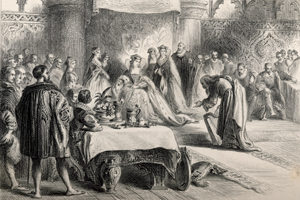 Although
Hogg appears to present a flattering portrait, there may well be
a double meaning in 'lies', recalling the Epistle's allusion to
Morrison's 'hyperbolical smile'. By 1813, Hogg seems to have tired
of Morrison's 'follies' and offers an unambiguously hostile depiction
in The Queen's Wake, debunking the gifts that he had earlier
professed to admire (albeit with a trace of irony). In
this highly popular poem, Hogg portrays his poetic peers in the
guise of bards participating in a poetic competition to mark the
return of Mary Queen of Scots to her homeland (portrayed left by
Keeley Halswelle). Morrison is portrayed as follows: Although
Hogg appears to present a flattering portrait, there may well be
a double meaning in 'lies', recalling the Epistle's allusion to
Morrison's 'hyperbolical smile'. By 1813, Hogg seems to have tired
of Morrison's 'follies' and offers an unambiguously hostile depiction
in The Queen's Wake, debunking the gifts that he had earlier
professed to admire (albeit with a trace of irony). In
this highly popular poem, Hogg portrays his poetic peers in the
guise of bards participating in a poetic competition to mark the
return of Mary Queen of Scots to her homeland (portrayed left by
Keeley Halswelle). Morrison is portrayed as follows:
The fifth was from a western shore,
Where rolls the dark and sullen Orr.
Of peasant make, and doubtful mein,
Affecting airs of proud disdain.
Wide curled his raven locks and high;
Dark was his visage, dark his eye,
That glanced around on dames and men,
Like falcons on the cliffs on Ken.
Some ruffian mendicant, whose wit
Presumed at much, for all unfit.
No one could read the character,
If knave or genius writ was there;
But all supposed from mein [sic] and frame,
From Erin he an exile came.
With hollow voice, and harp well strung,
‘ Fair Margaret’ was the song he sung,
Well known to maid and matron gray,
Through all the glens of Galloway.
When first the bard his song began,
Of dreams and bodings hard to scan,
Listened the Court, with sidelong bend,
In wonder how the strain would end.
But long ere that it grew so plain,
They scarce from hooting could refrain;
And when the minstrel ceased to sing,
A smothered hiss ran round the ring.
Red looked our bard around the form,
With eye of fire and face of storm;
Sprung to his seat with awkward leap,
And muttered curses dark and deep.
In his recent critical edition of The Queen's Wake (see Bibliography),
Douglas Mack suggests that the reference to 'Fair Margaret' may
hint at rivalry for the affections of Margaret Beattie, Hogg's
housekeeper (and mother of his illegitimate daughter Elizabeth)
(p. 411n). Following a suggestion from Gillian Hughes, he notes
that it might also reflect irritation at Morrison's 'flattering
behaviour' to Hogg's bride-to-be Margaret Phillips.
Morrison appears, unsurprisingly, to have been stung by his depiction
in The Queen's Wake. Mack argues that well be the author of an
unpublished anonymous satire, The Hoggiad, composed in
response to The Queen's Wake (mentioned in a letter from
Hogg to Scott of 3 April 1813, NLS MS 3884/122-23). In all events,
relations have clearly worsened by 1819, when Hogg inserts a revised
description of the 'fifth bard' in the 6th edition of The Queen's
Wake. Two stanzas no longer suffice to contain Hogg's vitriol.
The second stanza of the 1813 edition is now divided into two to
accommodate the new material (marked in bold):
With hollow voice, and harp ill strung,
Some bungling parody he sung,
Well known to maid and matron gray,
Through all the glens of Galloway.
For often had he conned it there,
With simpering and affected air.
Listened the Court, with sidelong bend,
In wonder how the strain would end,
But long ere that it grew so plain,
They scarce from hooting could refrain;
And each to others 'gan to say,
"What good can come from Galloway?"
Woe for the man so indiscreet!
For bard would be a name unmeet
For self-sufficient sordid elf,
Whom none admires but he himself.
Unheard by him the scorner's tongue,
For still he capered and he sung,
With many an awkward gape the while,
And many a dark delighted smile,
Till round the throne the murmurs ran;
Till ladies blushed behind the fan;
And when the rustic ceased to sing,
A hiss of scorn ran round the ring.
Dark grinned the fool around the form,
With blood-shot eye, and face of storm;
Sprung from his seat with awkward leap,
And muttered curses dark and deep.
Although Hogg is now best known his for novel The Private
Memoirs and Confessions of a Justified Sinner (1824), The
Queen's Wake was considered his masterpiece by his contemporaries,
and continued to be widely read throughout the nineteenth century.
Those few nineteenth-century historians or memoirists who recall
Morrison invariably cite the description of the 'fifth bard'
from the 1819 edition of The Queen's Wake, in a manner
that presupposes familiarity with Hogg's poem. Morrison's 'Reminiscences'
have been blamed for promoting the image of Hogg as a financial
simpleton incapable of managing his own affairs. It is important
to recall, however, that Morrison was evoking a figure who must
appeared to have branded him for all posterity. He doubtless
felt he was paying him back in his own coin.
Scott, conversely, remained on good terms with Morrison and commissioned
a number of artworks from him. When Morrison was to survey a railroad
from Glasgow to Berwick, Scott asked him to sketch castles and
collect ballads in the Upper Ward of Clydesdale. Again, when in
1809-10, Telford engaged Morrison to survey a road in Wales, Scott
asked him to sketch castles and glens and collection translations
of ballads. He also facilitated the publication by Constable of
a volume containing stone engravings made by Morrison from his
own sketches of Hermitage, Caerlaverock, Threave, Bruce, Duart,
and Ellandonan castles. Copies of these engravings remain on display
in Abbotsford, along with a set of pen-and-ink drawings of Galloway
landmarks that James B. Corson has attributed to Morrison.
Scott also helped Morrison find work as a portrait-painter, while
feeling that Morrison would be wiser not to abandon surveying entirely.
He commissioned paintings of his uncle Thomas Scott, of James Veitch,
Archibald Constable, the Ballantynes,
and members of the Abbotsford household such as Allister Dhu and
Tom Purdie. Indeed, according to Morrison, he wished him to produce
a gallery of the portraits of all of his friends. Little, if any,
of Morrison's portrait work appears, though, to have survived (or,
perhaps more accurately, to have been identified).
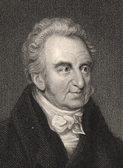 When
Morrison set out for Liverpool in his capacity as portrait-painter,
however, Scott sent a somewhat double-edged letter of introduction
to the historian William Roscoe (portrayed, right) which was published
in the introduction to Morrison's 'Reminiscences'. He describes
Morrison as 'a very worthy, as well as a very clever man' but opines
that 'though no judge of the art, I think he has mistaken his talents;
for, though he sketches remarkably well in outline, especially
our mountain scenery, and although he was bred to the art, yet
so long an interval has passed, that I should doubt his ever acquiring
a facility in colouring'. He therefore hope that something may
come up 'in a city where science is so much in request, to engage
him more profitably to himself, and more usefully to others, in
the way of his original profession as an engineer, in which he
is really excellent'. Scott 'should be sincerely glad, however,
that he throve in some way or other, as he is a most excellent
person in disposition and private conduct, an enthusiast in literature,
and a shrewd entertaining companion in society.' When
Morrison set out for Liverpool in his capacity as portrait-painter,
however, Scott sent a somewhat double-edged letter of introduction
to the historian William Roscoe (portrayed, right) which was published
in the introduction to Morrison's 'Reminiscences'. He describes
Morrison as 'a very worthy, as well as a very clever man' but opines
that 'though no judge of the art, I think he has mistaken his talents;
for, though he sketches remarkably well in outline, especially
our mountain scenery, and although he was bred to the art, yet
so long an interval has passed, that I should doubt his ever acquiring
a facility in colouring'. He therefore hope that something may
come up 'in a city where science is so much in request, to engage
him more profitably to himself, and more usefully to others, in
the way of his original profession as an engineer, in which he
is really excellent'. Scott 'should be sincerely glad, however,
that he throve in some way or other, as he is a most excellent
person in disposition and private conduct, an enthusiast in literature,
and a shrewd entertaining companion in society.'
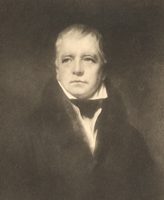 Roscoe
returned Scott's introductory letter to Morrison, shrewdly suggesting
that it would be of more value to him than to anyone else. Whatever
his own short-comings as a portraitist, Morrison was instrumental
in arranging for one of the finest portraits of Scott to be made.
In 1823, he undertook to persuade Scott to sit for Sir
Henry Raeburn,
on condition that he be permitted to attend the sessions and copy
the work as it progressed. Raeburn had already painted a likeness
of Scott in 1808,
but felt that it had 'a heavy look'. Scott had initially shared
Raeburn's reservations but had come to favour
the 1808 portrait over the more romanticised images produced by
subsequent painters. As such, he soon overcame his aversion to
sitting for yet another portrait ('Not only myself', he told Morrison,
'but my very dog growls when he observes a painter preparing his
palette.') Scott was, in Morrison's account, highly pleased with
the result, declaring to Raeburn: 'I wish none but your portraits
of me were in existence.' Morrison, usually so sparing of praise
-- elsewhere in his 'Reminiscences' he derides Wilkie's and Lawrence's
portraits of Scott -- concurs that it is 'by far, the best likeness
that has ever been painted'. (Click here for a page on Raeburn's
1823 portraits of Scott.) Roscoe
returned Scott's introductory letter to Morrison, shrewdly suggesting
that it would be of more value to him than to anyone else. Whatever
his own short-comings as a portraitist, Morrison was instrumental
in arranging for one of the finest portraits of Scott to be made.
In 1823, he undertook to persuade Scott to sit for Sir
Henry Raeburn,
on condition that he be permitted to attend the sessions and copy
the work as it progressed. Raeburn had already painted a likeness
of Scott in 1808,
but felt that it had 'a heavy look'. Scott had initially shared
Raeburn's reservations but had come to favour
the 1808 portrait over the more romanticised images produced by
subsequent painters. As such, he soon overcame his aversion to
sitting for yet another portrait ('Not only myself', he told Morrison,
'but my very dog growls when he observes a painter preparing his
palette.') Scott was, in Morrison's account, highly pleased with
the result, declaring to Raeburn: 'I wish none but your portraits
of me were in existence.' Morrison, usually so sparing of praise
-- elsewhere in his 'Reminiscences' he derides Wilkie's and Lawrence's
portraits of Scott -- concurs that it is 'by far, the best likeness
that has ever been painted'. (Click here for a page on Raeburn's
1823 portraits of Scott.)
Morrison's published recollections break off abruptly after he
recalls meeting a 'care-worn' Scott in the process of writing his Life
of Napoleon, a work which evidently 'sat heavy on his
spirits'.
Back to top
Back to Morrison Index
Back to
Biography Index
Last updated: 05-Nov-2004
© Edinburgh University Library
|
|

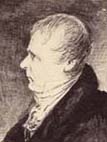
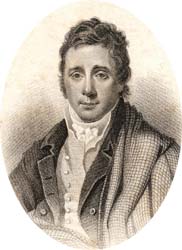
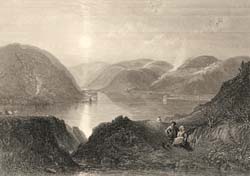
 Although
Hogg appears to present a flattering portrait, there may well be
a double meaning in 'lies', recalling the Epistle's allusion to
Morrison's 'hyperbolical smile'. By 1813, Hogg seems to have tired
of Morrison's 'follies' and offers an unambiguously hostile depiction
in The Queen's Wake, debunking the gifts that he had earlier
professed to admire (albeit with a trace of irony). In
this highly popular poem, Hogg portrays his poetic peers in the
guise of bards participating in a poetic competition to mark the
return of Mary Queen of Scots to her homeland (portrayed left by
Keeley Halswelle). Morrison is portrayed as follows:
Although
Hogg appears to present a flattering portrait, there may well be
a double meaning in 'lies', recalling the Epistle's allusion to
Morrison's 'hyperbolical smile'. By 1813, Hogg seems to have tired
of Morrison's 'follies' and offers an unambiguously hostile depiction
in The Queen's Wake, debunking the gifts that he had earlier
professed to admire (albeit with a trace of irony). In
this highly popular poem, Hogg portrays his poetic peers in the
guise of bards participating in a poetic competition to mark the
return of Mary Queen of Scots to her homeland (portrayed left by
Keeley Halswelle). Morrison is portrayed as follows: When
Morrison set out for Liverpool in his capacity as portrait-painter,
however, Scott sent a somewhat double-edged letter of introduction
to the historian William Roscoe (portrayed, right) which was published
in the introduction to Morrison's 'Reminiscences'. He describes
Morrison as 'a very worthy, as well as a very clever man' but opines
that 'though no judge of the art, I think he has mistaken his talents;
for, though he sketches remarkably well in outline, especially
our mountain scenery, and although he was bred to the art, yet
so long an interval has passed, that I should doubt his ever acquiring
a facility in colouring'. He therefore hope that something may
come up 'in a city where science is so much in request, to engage
him more profitably to himself, and more usefully to others, in
the way of his original profession as an engineer, in which he
is really excellent'. Scott 'should be sincerely glad, however,
that he throve in some way or other, as he is a most excellent
person in disposition and private conduct, an enthusiast in literature,
and a shrewd entertaining companion in society.'
When
Morrison set out for Liverpool in his capacity as portrait-painter,
however, Scott sent a somewhat double-edged letter of introduction
to the historian William Roscoe (portrayed, right) which was published
in the introduction to Morrison's 'Reminiscences'. He describes
Morrison as 'a very worthy, as well as a very clever man' but opines
that 'though no judge of the art, I think he has mistaken his talents;
for, though he sketches remarkably well in outline, especially
our mountain scenery, and although he was bred to the art, yet
so long an interval has passed, that I should doubt his ever acquiring
a facility in colouring'. He therefore hope that something may
come up 'in a city where science is so much in request, to engage
him more profitably to himself, and more usefully to others, in
the way of his original profession as an engineer, in which he
is really excellent'. Scott 'should be sincerely glad, however,
that he throve in some way or other, as he is a most excellent
person in disposition and private conduct, an enthusiast in literature,
and a shrewd entertaining companion in society.' Roscoe
returned Scott's introductory letter to Morrison, shrewdly suggesting
that it would be of more value to him than to anyone else. Whatever
his own short-comings as a portraitist, Morrison was instrumental
in arranging for one of the finest portraits of Scott to be made.
In 1823, he undertook to persuade Scott to sit for
Roscoe
returned Scott's introductory letter to Morrison, shrewdly suggesting
that it would be of more value to him than to anyone else. Whatever
his own short-comings as a portraitist, Morrison was instrumental
in arranging for one of the finest portraits of Scott to be made.
In 1823, he undertook to persuade Scott to sit for